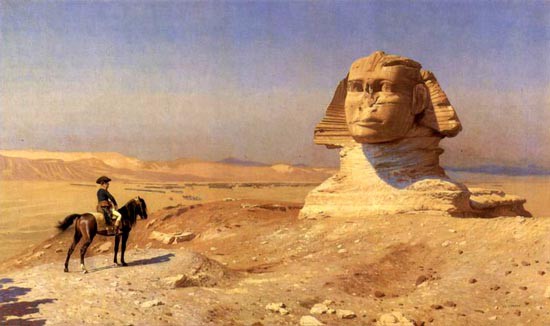Towards the end of the Second Empire, the legend of Napoleon began to take hold of Jean-Léon Gérôme, who proceeded to extract from the mythical Egyptian campaign such subjects that could be combined with his love for Orientalism. With the hundredth anniversary of Napoleon’s birth approaching (1869), in 1867 the artist rather appropriately came to the end of a series of canvases depicting General Bonaparte in Cairo and out in the desert. Paintings, such as the full-length portrait of the general standing before the Mamluk tombs in the City of the Dead, or astride his horse, contemplating the city and its monuments, portrayed Napoleon as the modern-day hero in touch with an enduring Egypt, a new Alexander meditating on the magnificence of a civilisation long since disappeared.
Having visited Egypt on no fewer than four occasions since 1855 (and for months at a time in some cases), Gérôme was well acquainted with the country. As far as the Napoleonic legend is concerned, however, it would appear to have been nothing more than a means to an end, a subject through which he could channel his fascination for the Orient. In this painting, the Sphinx – which takes up half the composition – dominates the solitary Bonaparte who, depicted on horseback, his hand resting on his thigh, is clearly unimpressed by the ancient colossus. As is often the case in Gérôme’s works, the significance of the composition is to be found in its framing. The perspective adopted by the painter deliberately supplants the pyramids on the Giza plateau in order to focus purely on this clash of the titans. Adept at finding the “moment” in his compositions, Gérôme freezes the action and brings to a halt the passage of time. Elements within the painting nevertheless hint at the imminent resumption of activity: the twitch of the horse’s tail, the shadows of Bonaparte’s general staff hanging over the bottom left-hand corner of the scene and, far away in the distance, troops manoeuvring in preparation for the famous Battle of the Pyramids, on 21 July, 1798, which saw the French army come face to face with the Mamluks of Murad Bey.
Gérôme, who was exceedingly fond of this canvas, presented it for the first time at the Salon of 1886 under the title Oedipus. In doing so, the artist drew heavily on classical Greek mythology, establishing a parallel between the man who liberated Thebes and the hero who brought salvation to France. Caricaturists, struck by the similarities between the shape of the sphinx’s head and the future emperor’s legendary hat, seized on the painting for their own purposes. One satirical cartoon, sensing a certain mise-en-abyme quality within the composition, was subtitled General Bonaparte’s shock at finding in the middle of the desert a colossal statue of Napoleon I!.
Karine Huguenaud (tr. H.D.W.)
December 2010


